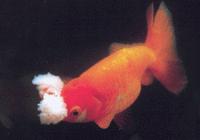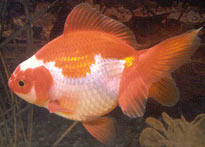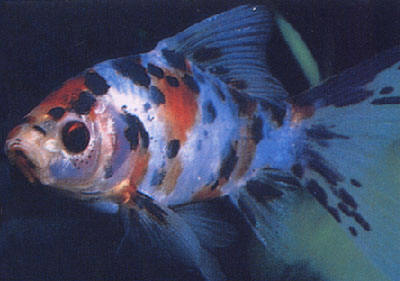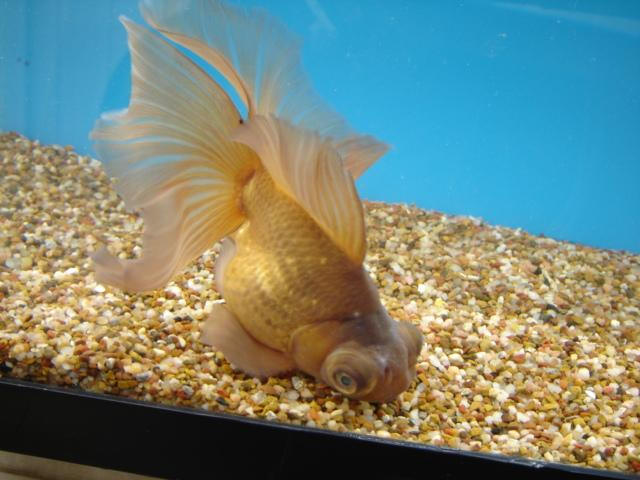| Description:GOLDFISH is a freshwater fish, genus Carassius, of the family Cyprinidae, popular in aquariums and ponds. Native to China, it was first domesticated centuries ago from the wild form, an olive-colored carplike fish up to 16 in. (40 cm) long. It reverts to this type when it escapes from domestication and has been known to hybridize with the carp . Breeders have developed bizarre varieties with fan, fringe, or veil tails and sometimes with double or triple fins. Some have bulging "telescope" eyes. For a description of the different variety, please refer to variants below: Habitat/Care:Goldfish natively live in ponds, and other slow or still moving bodies of water in depths up to 20 m (65 ft). Their native climate is subtropical and they live in freshwater with a 6.0–8.0 pH, a water hardness of 5.0–19.0 dGH, and a temperature range of 40 to 106 °F (4 to 41 °C) although they will not survive long at the higher temperatures. Indeed, they are considered ill-suited even to live in a heated tropical fish tank, as they are used to the greater amount of oxygen in unheated tanks also the heat burns them. In the wild, the diet consists of crustaceans, insects, and plant matter. While it is true that goldfish can survive in a fairly wide temperature range, the optimal range for indoor fish is 68 to 75 °F (20 to 23 °C). Pet goldfish, as with many other fish, will usually eat more food than it needs if given, which can lead to a fatal intestinal blockage. They are omnivorous and do best with a wide variety of fresh vegetables and fruit to supplement a flake or pellet diet staple. Sudden changes in water temperature can be fatal to any fish, including the goldfish. When transferring a store-bought goldfish to a pond or a tank, the temperature in the storage container should be equalized by leaving it in the destination container for at least 20 minutes before releasing the goldfish. In addition, some temperature changes might simply be too great for even the hardy goldfish to adjust to. For example, buying a goldfish in a store, where the water might be 70 °F (approximately 21 °C), and hoping to release it into your garden pond at 40 °F (4 °C) will probably result in the death of the goldfish, even if you use the slow immersion method just described. A goldfish will need a lot more time, perhaps days or weeks, to adjust to such a different temperature. Because the goldfish likes to eat live plants, keeping it with plants in an aquarium can be quite a problem. Only a few of the aquarium plant species can survive in a tank with goldfishes, for example Cryptocoryne and Anubias species, but they require special attention so that they are not uprooted. History:During the Tang Dynasty, it was popular for Chinese ponds to have carps. As the result of a genetic mutation one of these carp displayed "gold" (actually yellowish orange) rather than silver coloration. This mutation is associated with a dominant gene which also makes the breeding of this trait rather easy. The gold-coloured strain became popular for keeping in containers. Afterwards, the people began to breed the gold variety instead of the silver, and began to keep them into small containers to watch. As bred in captivity, more mutations occurred producing more colours and fancy goldfish appeared. According to old books, the occurrence of other colours were first recorded in AD 1276. In the Ming Dynasty it was recorded the first occurrence of fancy tailed goldfish. In AD 1502, goldfish were introduced to Japan, where it had been developed the Ryukin and Tosakin varieties. In AD 1611, Goldfish were introduced to Portugal, the starting point from which they were introduced to other parts of Europe. The goldfish was finally introduced to North America in AD 1874. Mixing with other fishes:Most goldfish are generally social, able to be kept with a variety of other fish without complication. They enjoy swimming and playing in groups, and while occasional individuals can become aggressive, the overall breed is friendly. They can become quite tame eating from hands and swimming frantically towards the owner in the hope of food. Diet:Like most fish, goldfish are opportunistic feeders, meaning they will eat whenever food is available, whether they are hungry or not. This habit can be fatal. Their digestive tract can become so jammed with food that the intestines tear open, killing the fish. Also, an excess of food means more waste and feces, which pollute the tank. Goldfish should only be fed as much food as they can consume in 3 to 4 minutes, and no more than twice a day. A good way to tell if your goldfish is being properly fed is to look as their feces. They should be short and chunky, the same color as the food the fish is eating. Long strings of waste that trail behind the fish as they swim could be a sign of over-feeding. Care has to be taken when choosing the right food for them, because goldfishes need less protein (which they cannot digest in excess) and more of the easy to digest carbohydrates. However, specialised food for them can be found on the market. Breeding:Goldfish, like all cyprinids, are egglayers. They produce adhesive eggs which attach themselves to aquatic vegetation. The eggs hatch within 48-72 hours, releasing fry large enough to be described as appearing like "an eyelash with two eyeballs". Within a week or so, the fry begin to look more like a goldfish in shape, although it can be as much as a year before they take their mature goldfish color, until then they are a metallic brown like their wild forebears. In their first weeks of existence, the fry grow remarkably fast; an adaptation borne of the high risk of getting devoured by the adult goldfish (or other fish and insects) in their environment. Goldfish can only grow to sexual maturity if given enough water and the right nutrition. However if kept well, they may breed indoors. Breeding usually happens after a significant change in temperature, often in spring. Eggs should then be separated into another tank, as the parents will likely eat any of their young that they happen upon. Dense plants such as Cabomba or Elodea or a spawning mop are used to catch the eggs. Most goldfish can and will breed if left to themselves, particularly in pond settings. Males chase the females around, bumping and nudging them in order to prompt the females to release her eggs, which the males then fertilize. |
Variants:Selective breeding over centuries has produced several color variations, some of them far removed from the "golden" color of the originally domesticated fish. There are also different body shapes, fin and eye configurations. Some extreme versions of the goldfish do need to be kept in an aquarium — they are much less hardy than varieties closer to the "wild" original, however more robust variations such as the Shubunkin are more hardy. The main varieties are:
| |
Photo Galley
Got a photo? Contact me.
 Ryukin |  Bubble Eye |  Short tailed Ryukin |
 Orange pom pom |  Black and white Oradana |  Panda Moor |
 Lionhead |  Celestial Eye |  Fantail |
 Shubunkin |  Pearl Scale |  Pair of Pearl Scale |
Links to other awesome GoldFish sites:
1. http://www.chinagoldfish.com/english/fantail-ryukin.htm awesome site for goldfish pics.
2. http://www.goldfishutopia.net/ a great site with a large variety of goldfish for sale
3. http://www.bristol-aquarists.org.uk/ a wonderfully informative site about goldfish.
4. http://www.goldfishpages.com/ another great site with extensive photo galley.
5. http://www.thegoldfishbowl.co.uk/ contains good information on gold fish.
6. http://www.liveaquarium.com/ this site sell good quality gold fishes.
References Cited:
1. Goldfish, [Online], Available http://en.wikipedia.org/wiki/Goldfish#See_also
2. Sexing Goldfish [Online], Available http://www.bristol-aquarists.org.uk/goldfish/info/sexing-fs.htm
3. The Columbia Encyclopedia, sixth edition, GoldFish [Online], Available http://www.bartleby.com/65/go/goldfish.html



































No comments:
Post a Comment